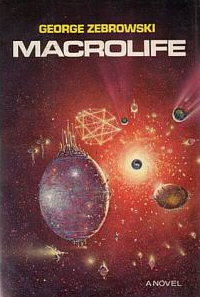Plot summary
The novel is split into three main sections.
(I) Sunspace: 2021 ... The Bulero family/corporation, inventors and marketers of Bulerite which is used to build the huge cities which house the Earth's (and colonies) teeming millions, are at the pinnacle of their influence and wealth. Unfortunately, it is discovered - too late - that the substance is inherently flawed, in that after a time it destabilizes and self-destructs with spectacular results. Gradually, all the Bulerite on Earth, and that on and in the space colonies throughout the solar system becomes unstable, causing destruction and megadeath.
The devastation precipitates a war with Earth's colonies on the outer planets, with whom a struggle for control of the solar system existed. Many nuclear-tipped missiles explode on Earth which adds to the Bulerite destabilization. The combination of the Bulerite and the nuclear explosions cause a mysterious shroud of radiation to envelop the Earth. All humans on the planet are assumed dead.
Before this final devastation, many refugees manage to escape to the Moon, Mars, and Asterome, an orbiting colony situated inside a hollowed-out asteroid at the Moon's L5 point. Included amongst the refugees are most of Bulero family who end up on Asterome.
The leadership of Asterome are now faced with several severe challenges: Handling the influx of refugees, removing any Bulerite used in the construction of Asterome, consolidating their resources now that the Earth can no longer supply them with finished goods, and preventing increasingly aggressive attempts by the outer colonies and remnants of Earth's government to take control and plunder Asterome.
When a means of providing Asterome with propulsion is discovered, the leadership of Asterome decide that leaving the solar system is the best option available to ensure Asterome's short-term survival as well as proving a way for Mankind to survive should the solar system be destroyed by the after-effects of Bulerite and war.
After overcoming attempts to stop them, Asterome finally manages to leave the solar system, heading for Alpha Centauri, the nearest star.
(II) Macrolife: 3000 ... A thousand years later, Asterome has grown by adding concentric layers of shells around itself, and is now host to millions of humans and Humanity II cybernetic organisms.
The invention of engines that can surpass the speed of light has made it possible for the colony to explore far and wide; the second part finds them studying a planet orbiting the star Praesepe over 500 light years away. John Bulero, a young clone of one of the original Bulero's, decides to see what life is like on a planet, and lives for a while amongst the natives, descendants of a human colony that has reverted to savagery. His experiences, while tragic, enable him to grow as an individual.
Eventually, Asterome travels back to the solar system to see how events there have unfolded. Their arrival coincides with the first time humans meet an intelligent alien species which is itself experimenting with Macrolife, and, together, the species begin a process of intermingling and further expansion into the universe.
(III) The Dream of Time ... A hundred billion years have passed, and Macrolife is now the dominant culture throughout the universe, which is, at this stage, beginning to contract into its final death throes. Most life is in the form of a Hyperpersonal Aggregate; an amalgam of individuals of all kinds. The aggregate re-individualizes John Bulero again, to help them solve the problem of how Macrolife can survive beyond the death of the Universe. Eventually, they discover many Macrolife survivors from many previous cycles of the universe, who help them to conquer time itself.
